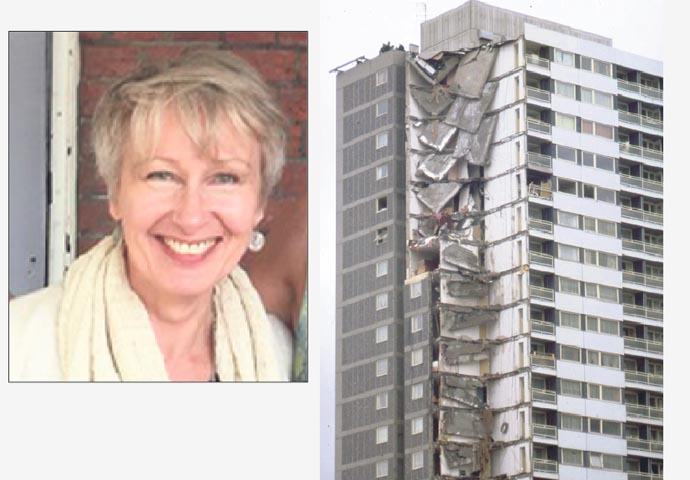Who will highlight building defects?
Who will now listen to tenants’ and residents’ fears on unsafe conditions, poor work, or poor design, asks Dee Searle
Thursday, 24th November 2022 — By Dee Searle

Ronan Point: a devastating gas explosion killed four and injured 17 people in 1968. [Photo: Derek Voller/Ronan Point collapse, Canning Town / CC BY-SA 2.0]
ONE of my most vivid memories of campaigning architect Sam Webb was being stuck in a broken lift halfway down the notorious Ronan Point tower block with him and three Building Research Establishment engineers.
Our timing was unfortunate because it was during stress tests to see if the building really was as unstable as Sam predicted (An architect for safety, John Gulliver, November 3).
We could feel the 22-storey building swaying as the four massive weights installed at the top corners of the block rotated.
It was in 1985, so no one had a mobile phone to call for help and the tenants had all been rehoused elsewhere.
Luckily, just as my fellow prisoners were agreeing that it made sense to shove me (as the smallest person there) through the emergency ceiling hatch to seek help, we were rescued by a security guard doing his rounds who heard the lift’s feeble alarm.
Unreliable lifts, along with structural defects, poor fire safety and persistent damp, were daily fare for Sam in his quest to expose the state of many high-rise housing blocks.
As a journalist I was fortunate to be able to collaborate with him on several stories.
My other vivid memories of him were his bravery in tackling senior figures in the architectural profession, construction industry and local authorities, and his genuine connection with the tenants.
He took their concerns seriously and used his skills and experience to investigate them.
Sam’s work led to the 1986 demolition of Ronan Point in Canning Town, which had been rebuilt after a gas explosion in 1968 ripped out a corner of the block, killing four people and injuring 17 more.
The piece-by-piece dismantling revealed extensive defects, including cracks to load-bearing concrete on the lower floors. Experts later concluded that the building was unlikely to have survived the “Great Storm” of 1987.
Many councils across Britain owned high-rise housing blocks constructed from the same or similar low-cost, large panel, prefabricated, building systems, so the knock-on effect was huge, resulting in massive programmes of demolition or strengthening.
The overriding takeaway is that Sam Webb was right to listen to the fears of tenants and residents. They often spot poor workmanship, unsafe conditions, or impractical layouts, that those in power can’t or won’t see.
Tragically, listening to tenants and residents could have saved lives lost because of the fires at Grenfell Tower in North Kensington in 2017 and Lakanal House in Camberwell in 2009.
Less dramatically it could also save money and improve outcomes on Camden Council’s estate regeneration schemes, such as Alexandra Road and West Kentish Town.
Admittedly new housing in Camden wins its share of architectural prizes.
However, gongs produced by the mutually-supportive architectural awards industry in London – before the cement is barely dry – are not a true assessment of housing quality.
One of the big lessons of the past is that it’s surely sensible and honest to wait a decade or so before reaching grand conclusions that housing “regeneration” schemes are any good.
Meanwhile Camden’s new social or “affordable” family homes are packed into high-rises, or other dense developments, potentially incubating the structural and social problems of the future.
Without Sam Webb, who will hear and act on the next generation of inconvenient truths?
• Dee Searle is a community activist and former journalist.